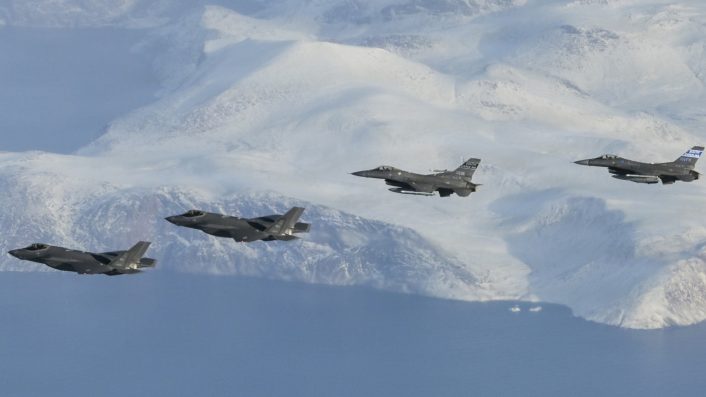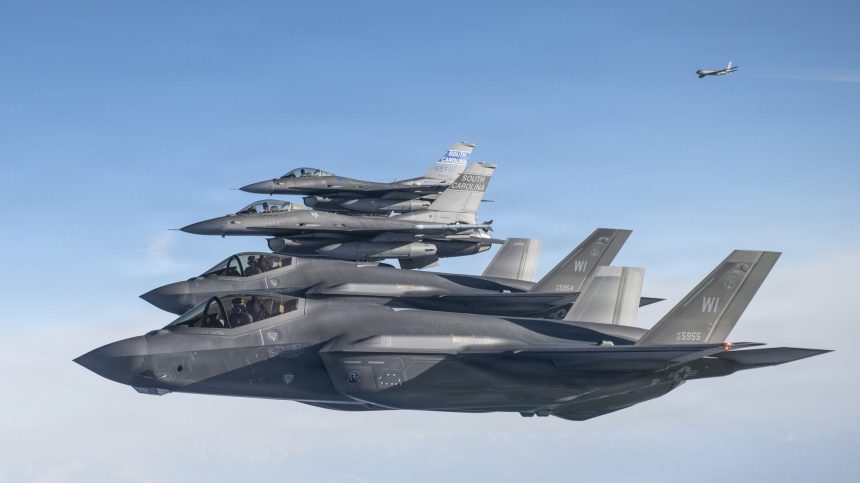The mission was supported by the Royal Danish Air Force, underscoring Denmark’s contribution in the security of the Arctic, and Greenland’s role in the defense of North America.
In the second such deployment this year, U.S. Air Force F-35A Lightning IIs, a KC-135 Stratotanker and F-16 Fighting Falcons deployed to Greenland’s Pituffik Space Base. This was part of a four-day operation early in October, described as a “dynamic operational exercise,”NORAD (North American Aerospace Defense Command) and AFNORTH (Air Forces North) revealed in an Oct. 29, 2025, press release.
The RDAF (Royal Danish Air Force) also supported the deployment with a CL-604 Challenger. The two Lightning IIs from the Wisconsin ANG’s 115th Fighter Wing (115th FW) and two F-16C Block 52s from the South Carolina ANG’s 169th FW were supported by a KC-135 Stratotanker from the 128th Air Refuelling Wing (128th ARW) of the Wisconsin ANG.
The press release said the operations began on Oct. 8 and all the aircraft departed Greenland by Oct. 11, similarly to the photos’ captions and the VIRIN names assigned to the photos. However, the photos’ details on DVIDS mention that the pictures were taken on Aug. 16.
#NORAD‘s ability to defend North America is built upon the foundation of partnerships. The U.S., Canada and the Kingdom of Denmark have an interest in collective defense that will strengthen the unity of effort in the #HighNorth. #WeHaveTheWatch #StrongerTogether https://t.co/uy9gTt4xlA
— North American Aerospace Defense Command (@NORADCommand) October 10, 2025
Increasing activity in the Arctic
Pituffik, originally known as Thule Air Base before Denmark renamed it in 2023, is the U.S. Department of Defense’s northernmost installation in the Arctic, supporting space-based missions, missile warning systems, and satellite tracking. The base is located approximately 750 miles north of the Arctic Circle.
The first such deployment took place late in January 2025 when NORAD sent two F-16s to Greenland. These were to support the Canadian NORAD Region’s (CANR) and Alaskan NORAD Region’s (ANR) force of two Canadian CF-18s, two KC-135s, two F-35s and one E-3C AWACS that were sent up to monitor what NORAD described as “Russian military aircraft activity in the Arctic.”
Sep. 24 also saw U.S. F-16s intercepting a formation of Russian aircraft including Tu-95 Bear bombers and Su-35s in the Alaskan ADIZ (Air Defense Identification Zone).

NORAD’s latest ‘Dynamic Operational Exercise’ in Greenland
NORAD said the F-35A, F-16 Fighting Falcon and KC-135 surge to the “strategically important location” was to “exercise readiness and strengthen interoperability with Danish partners.” The exercise highlights the critical role Greenland plays in the defense of North America and “the importance of enhanced Arctic operational readiness.”
Operations began Oct. 8, with the first aircraft returning to their home station on Oct. 9, and all aircraft departing Greenland by Oct. 11. The collaboration of the RDAF’s Bombardier Challenger 604 aircraft with NORAD helped “maintain a constant state of readiness for Search and Rescue (SAR) operations,” the NORAD statement added. The RDAF CL-604 was also employed when the RDAF sent two F-16AMs for a short two-hour visit to Greenland’s Pitiffuk on Jun. 25.
The Challenger aircraft is a militarized version of the Bombardier Challenger 600 series of business jets, that the RDAF often uses for maritime patrol and trips to the Arctic, where it is suitable for the frequently rough gravel-covered strips. The RDAF’s highly trained SAR coverage was a “vital capability in the demanding Arctic environment, ensuring the safety and well-being of all participants.”

The overall mission was overseen by NORAD’s 1st Air Force (Air Forces Northern and Air Forces Space). NORAD said Greenland’s “strategic location makes it a vital component in the defense of North America.”
The statement further added that, “since June, U.S. Northern Command has assumed responsibility for ensuring defense of the homeland vis-à-vis Greenland. The United States is committed to strengthening its cooperation with the Kingdom of Denmark in the region.”
The exercise this time also saw the bi-national U.S.-Canada NORAD working with Denmark in an effort to “contribute to our collective security.” The statement mentioned “this exercise is just one example of ongoing efforts to bolster Arctic security and ensure NORAD’s ability to effectively monitor and respond to potential threats.”
The Greenland administration’s support is also critical to enable “adaptability and flexibility needed to overcome logistical hurdles in a dynamic and unforgiving environment,” said a caption. “Greenland, as part of the Kingdom of Denmark, has long played an important role in the defense of North America, which strengthens NORAD’s ability to protect the continent from today’s threats and emerging challenges from all approaches,” further stated the caption.

Meticulous planning and execution
The NORAD release quoted 1st Air Forces Northern and Air Forces Space commander Lt. Gen. Luke Ahmann, who said how the exercise demonstrated the USAF’s “ability to quickly and efficiently deploy forces to the Arctic, showcasing the adaptability necessary to operate in this unique and demanding environment.”
“More importantly, it highlighted the strength of our partnership with the Kingdom of Denmark,” continued Ahmann. “We deeply value their collaboration and the critical support they provide, particularly the Royal Danish Air Force’s commitment to search and rescue capabilities in this region. Their partnership is essential to ensuring the safety and security of operations in the Arctic.”
The deployment could be considered a DFE (Dynamic Force Employment) exercise, which includes sudden and rapid deployment to a forward location with little notice, usually in cooperation with an ally, and generally at austere locations with little infrastructural support.
Danske F-16 er lige nu i Grønland, hvor de er en del af Forsvarets faste suverænitetshåndhævelse i Kongeriget og Forsvarets øgede tilstedeværelse i Grønland.
F-16 piloterne tog turen fra Danmark til Grønland med støtte fra et fransk MRTT lufttankningsfly fra Armée de l’Air et de… pic.twitter.com/N9TD1u0cq1
— Forsvaret (@forsvaretdk) June 25, 2025
CONR-1AF’s (AFNORTH and AFSPACE) Maj. Daniel Schottle said the “unique challenge” in the “rapid timeline” involved a host of ground logistical planning and setup. This comprised “setting up a forward operating location within days, from coordinating the movement of personnel and equipment to ensuring adequate support on the ground, required meticulous planning and seamless execution.”
“The success of this exercise demonstrates the exceptional capabilities and dedication of our Airmen and the strength of our partnership with the Kingdom of Denmark,” Schottle added. The exercise also comes amid President Donald Trump’s ambitions of annexing Greenland, a Danish semi-autonomous region, comments that were seconded by his Secretary of State Marco Rubio.
Denmark is also a leading NATO member and actively participates in the European theater, and has been gradually replacing its older F-16s at Skrydstrup Air Force Base with F-35As for the alliance’s QRAs (Quick Reaction Alert) duties.









